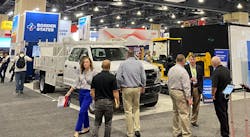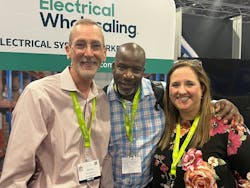Since returning home from the 2023 NECA convention and trade show in Philadelphia, held September 29 to October 2 at the Pennsylvania Convention Center, I realize there’s a lot to unpack from the three-day event. After walking the extensive exhibit hall floor, seeing all of the latest new products and services exhibitors had to offer, meeting with manufacturers to learn more about their strategic initiatives as well as what they believe are the “next big things” for our audience, attending valuable educational workshops presented by subject matter experts, and talking with attendees about what challenges and opportunities they’re seeing in the field, I came away with a renewed sense of inspiration and optimism about all things electrical. Although there are obviously a significant number of obstacles that persist in the electrical construction and maintenance industry going forward — supply chain issues, material price increases, equipment delivery delays, and the skilled worker shortage to name a few — it seems like there’s never been a better time to be in the electrical trade.
A few key themes definitely stood out to me at this year’s show. Job-site productivity and ergonomics are always top of mind for electricians, so it was no surprise we saw lots of upgraded tools, new slick software capabilities and apps, and integrated accessories/components on display that promise users the ability to do their jobs more efficiently, effectively, and safely at this year’s show. Prefabrication and pre-assembled solutions also seemed to pique many attendees’ interest, especially those working on large-scale electrical projects. Along those same lines, talk of how electrical professionals can harness the power of emerging artificial intelligence (AI) tools to maximize productivity and boost revenue was also a hot topic. Still considered by many as an existential threat not only to the skilled trades but also to society in general, AI is inevitably here to stay, so savvy electrical professionals who figure out a way to gain a competitive advantage with this technology will ultimately reap the benefits.
Stemming from the influx of federal dollars expected over the next five to 10 years from the Infrastructure Investment and Jobs Act( IIJA), everyone was talking about much-needed electric grid updates and what doors that may open for new technologies and innovation, adoption of more renewable resources (solar and wind) as well as battery storage, distributed generation, and microgrid applications in the future. Another obvious trend at this year’s show was the prevalence of electric vehicle (EV) chargers and software products. You’d be hard pressed to pass more than a few booths before you saw another EV charging solution. They were everywhere. Considering the current IIJA goal of building out a national network of 500,000 public EV charging stations by 2030, it’s no surprise most manufacturers are jumping on this bandwagon — even if this won’t be a core market for them (which it won’t be for the majority), making sure they have at least a few horses in this race will open up a new revenue stream, nonetheless.
In conjunction with these key themes, the October print issue, coming soon to www.ecmweb.com, features several articles that should be of interest to the majority of our audience. The cover story by Freelance Writer Tim Kridel provides a timely update on electric vehicle charging regulations. Is the power grid really ready to handle electric vehicles? Tommy Northcott answers this question in his piece. On a similar note, Freelance Writer Amy Fischbach examines what building and maintaining the grid of the future will actually entail. And the article from Sean Nacey of Wesco on the pros and cons of pre-assembled solutions for solar farms provides unique perspective on what contractors in the field are experiencing firsthand. Following all of my discussions with attendees and manufacturers, I’m excited to see how all of these trends shape up in the coming year.
About the Author
Ellen Parson
Editor-in-Chief - EC&M
Ellen Parson is the Editor-in-Chief for EC&M. She has a journalism degree from the University of Missouri-Columbia. She's been a business-to-business writer and editor for more than 25 years, most of which have been covering the construction and electrical industries. Contact her at [email protected].


